Maus — Some Background
The Maus series, written and drawn by Art Spiegelman, was serialized from 1980 to 1991. It was collected into two books: Maus 1: A Survivor's Tale: My Father Bleeds History (1986), and Maus II: A Survivor's Tale: And Here My Troubles Began (1992). (You might know Spiegelman from one of his huge commercial successes, the Garbage Pail Kids trading cards, by Topps.)
In 1992, Spiegelman was awarded a Pulitzer Prize for Maus, the first for a cartoon artist. The Wall Street Journal said it was "the most affecting and successful narrative ever done about the Holocaust”; The New Yorker called it “the first masterpiece in comic book history.”
This complicated series has three different story lines:
Vladek Spiegelman and his experiences before, during, and immediately after WWII. |
Vladek as he is relating the previous story to his son, Art. |
Art, as he is writing and illustrating his father's story. |
 |
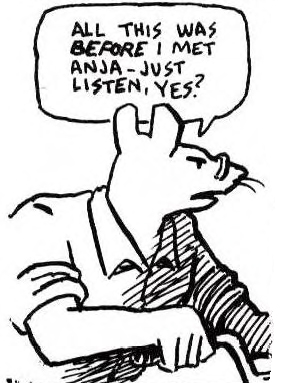 |
 |
All of these stories are presented in an overarching metaphor, where different groups of people are presented as various animals.
Mice (Jews)
Spiegelman himself walked through his thought processes in a 2011 interview with The New York Review of Books. I'm excerpting from it here:
The most shockingly relevant anti-Semitic work I found was The Eternal Jew, a 1940 German “documentary” that portrayed Jews in a ghetto swarming in tight quarters, bearded caftaned creatures, and then a cut to Jews as mice—or rather rats—swarming in a sewer, with a title card that said “Jews are the rats” or the “vermin of mankind.” This made it clear to me that this dehumanization was at the very heart of the killing project.
In fact, Zyklon B, the gas used in Auschwitz and elsewhere as the killing agent, was a pesticide manufactured to kill vermin—like fleas and roaches.
I found how regularly Jews were represented literally as rats. Caricatures . . . filled the pages of Der Stürmer: grubby, swarthy, Jewish ape-like creatures in one drawing, rat-like creatures in the next. Posters of killing the vermin and making them flee were part of the overarching metaphor. It’s amazing how often the image still comes up in anti-Semitic cartoons in Arab countries today.
 A poster advertising The Eternal Jew |
 A title card from The Eternal Jew |
 A cartoon from Der Stürmer |
Cats (Germans)
From Spiegelman:
There was one rendering of a cat in full Nazi drag that looked sort of like Marlon Brando in The Young Lions. It was the most noble and savage version of the Nazis, tying into the stereotypes that presented Nazis as somehow sexy. It reminded me of the whole Night Porter genre of pornography that involved SS uniforms and scared me away from drawing Maus with really large-scale cats.
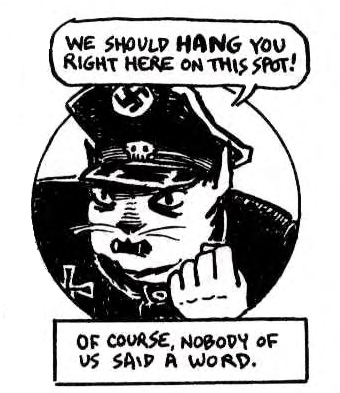 German / Cat |
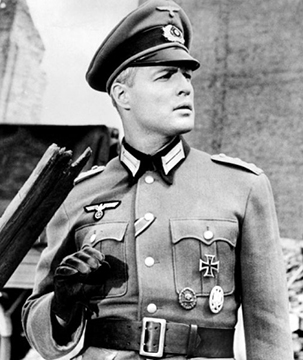 Brando in The Young Lions |

Pigs (Poles)
This is the most controversial of all of Spiegelman's characterizations, and has caused a sustained backlash against this work. Poles see it as offensive and unfair. Spiegelman knew that his father, even though he was Polish himself, distrusted Poles who weren't Jewish. So he notes that,
my metaphor [mice to be killed outright, and pigs to be exploited and eaten] was somehow able to hold that particular vantage point while still somehow acknowledging my father’s dubious opinion of Poles as a group.” (Metamaus 122). "And considering the bad relations between Poles and Jews for the last hundred years in Poland, it seemed right to use a non-Kosher animal.” (Metamaus 125).
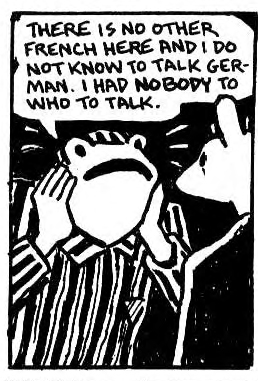
Frogs (French)
From The Racial Slur Database:
The French are said to laugh like frogs. When they laugh, their adam's apples bulge out of their necks like frogs. Also perhaps from the French delicacy of frog-legs. Another possible derivation is the Fleur-de-Lys displayed on the French king's banner in the Middle Ages, which, to the English enemy, looked like squatting frogs.

Dogs (Americans)
US soldiers complained that they were treated "like dogs" in training. In theater, they lived in "pup tents" and foxholes. They had dog tags for identification (a practice that came from the US Civil War, where wounded soldiers had tags tied to them like those put on a pet dog, in order to identify their wounds). Only Infantrymen are called dogfaces, because they spent most of their time dirty, cold, and wet, like a hunting dog.
In 1942 two US Infantrymen wrote and recorded a song, "The Dogface Soldier." It was almost immediately adopted as the song of the 3rd Infantry Division, and was widely played and sung during the war. In the war the Third Infantry Division was credited with 531 combat days, the most of any unit in the European Theater. It was the only US unit that served in all 10 campaigns of the war, and suffered the most casualties of any US unit in the theater.
"Dogface Soldier"
I wouldn't give a bean to be a fancy pants Marine;
I'd rather be a dogface soldier like I am.
I wouldn't trade my old O.D.s for all the Navy's dungarees,
For I'm the walking pride of Uncle Sam.
On Army posters that I read
It says "Be all that you can,"
So they're tearing me down
To build me over again!
I'm just a dogface soldier
With a rifle on my shoulder,
And I eat raw meat for breakfast every day.
So feed me ammunition,
Keep me in the 3rd Division
Your dogface soldier's A - OK.
From Spiegelman:
But dogs were easy; it’s almost the Family Feud answer to what animals come to mind and how do you perceive them. The dogs were heroic vanquisher of cats, so there was that. . . . Here, the fact that there were so many possible dogs got me to actually verbalize to myself: “Oh, I get it. Americans are a mongrel race, a bunch of mutts.” Bill Mauldin’s panel cartoons of Willie and Joe – the “dogfaces” of World War II as GIs were called – came to mind as soon as I started trying to figure out what it might mean to draw a dog in an army uniform.
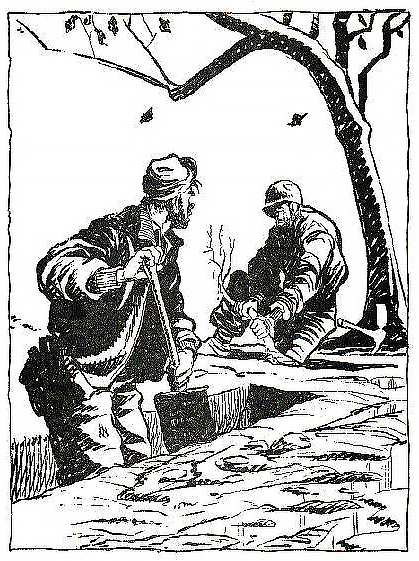 "Me future is settled, Willie. I'm gonna be a perfesser on types o' European soil." |
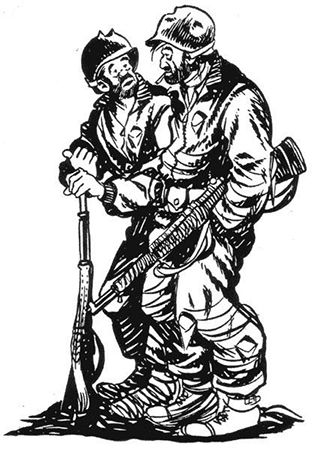 Willie and Joe |
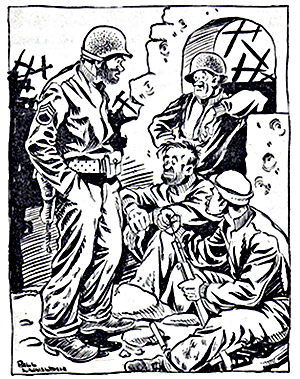 "I need a couple guys what don't owe me no money for a routine patrol." |

Moths (Roma)
From Spiegelman:
Well, for one thing, they're gypsy moths, so even the name fits. Also, moths fit with an imagery of itinerancy — flitting from place to place, but never stopping for long — which makes them a reasonable choice to symbolize gypsies.
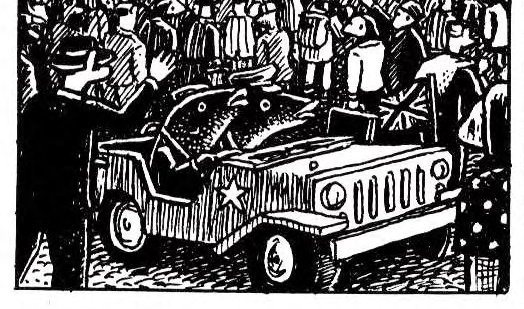
Fish (British)
From Spiegelman:
I guess I could have avoided the whole issue since they [the British] just appear in the mise-en-scène for a panel or two, but I decided to give the Brits a walk-on part — or, as it finally resolved itself, a swim-on part. I thought about fish and chips, an island culture, fish out of water. All those things just seemed to lead me toward drawing fish without bicycles but with jeeps.

Reindeer (Swedish)
From Spiegelman:
Sweden was quite welcoming to refugees after the war. I thought of the Swedes as somehow far outside the loop of my Eastern European narrative and finding an animal so totally out of the scale with mice, cats, and mutts — those large galumphing and gentle reindeer — struck me as amusing.
Other Material
The Cat - Mouse - Dog Dynamic
We're all familiar with the "Cat and Mouse" relationship, and with the "Cats and Dogs" relationship. They're natural enemies, and in the case of mice, they are prey. But when you put all three together, the mouse is assisted by the dog, who is the alpha power in the dynamic.
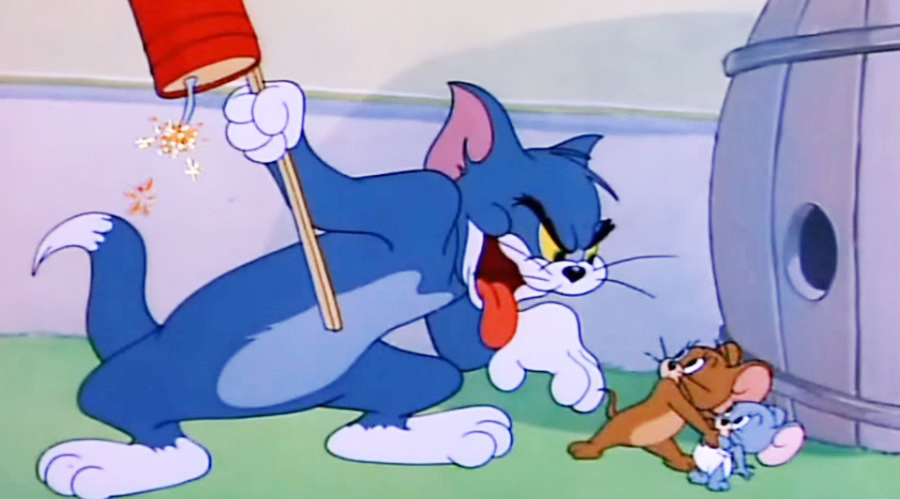 Plenty of cartoons play on this trope |
 Tom and Jerry began in 1940; it influenced American propaganda in WWII |
 Once Spike enters the fray, Jerry is protected | |
Reappropriation — The Pink Triangle
In sociology and cultural studies, reappropriation or reclamation is the cultural process by which a group reclaims — re-appropriates — terms or artifacts that were previously used in a way disparaging of that group.
The most successful reappropriation of Nazi symbolism is the pink triangle. The Nazis used it in the camps to identify male homosexuals.

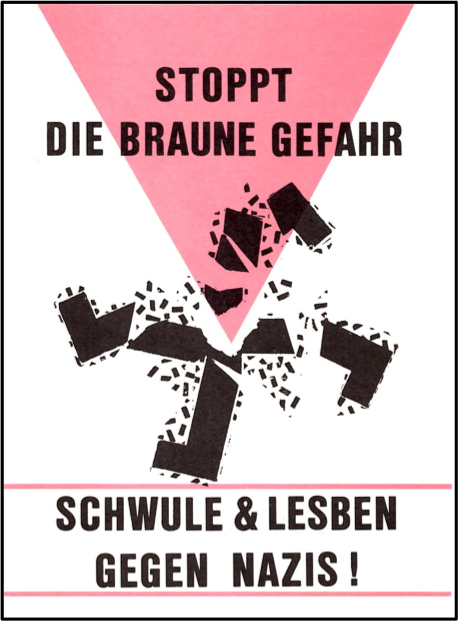
Gays and Lesbians against Nazis!”
In 1973, post-war Germany’s first gay rights organization, Homosexuelle Aktion Westberlin (HAW), reclaimed the pink triangle as a symbol of liberation. They featured it prominently on a sticker they wore to protest the rise of Neo-Nazi groups in Germany. Members of HAW stated that the pink triangle was not just a reminder of a past that had been silenced for decades, but was also applicable to the present day: ". . . we want our group’s symbol to highlight the continued oppression of homosexuals in 1970s Germany, too."

In 1987, six New York City artists created a poster with the words "SILENCE = DEATH" and a pink triangle, meant to call attention to the AIDS crisis that was ravaging populations of gay men across the country. The symbol was adopted by ACT UP (the AIDS Coalition to Unleash Power), which was formed soon after the poster was first printed. Their actions and protests, held at places like the New York Stock Exchange, Wall Street, and Cosmopolitan magazine, kept the poster always in the public eye.
The poster has come to represent AIDS activism throughout the world.